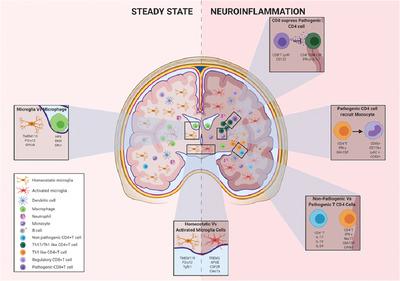当前位置:
X-MOL 学术
›
J. Leukoc. Biol.
›
论文详情
Our official English website, www.x-mol.net, welcomes your
feedback! (Note: you will need to create a separate account there.)
Neuroinflammation at single cell level: What is new?
Journal of Leukocyte Biology ( IF 3.6 ) Pub Date : 2020-08-10 , DOI: 10.1002/jlb.3mr0620-035r W N Brandão 1 , M G De Oliveira 1 , R T Andreoni 1 , H Nakaya 2 , A S Farias 3, 4 , J P S Peron 1, 5, 6
Journal of Leukocyte Biology ( IF 3.6 ) Pub Date : 2020-08-10 , DOI: 10.1002/jlb.3mr0620-035r W N Brandão 1 , M G De Oliveira 1 , R T Andreoni 1 , H Nakaya 2 , A S Farias 3, 4 , J P S Peron 1, 5, 6
Affiliation

|
Multiple sclerosis is a chronic and demyelinating disease of the central nervous system (CNS), most prevalent in women, and with an important social and economic cost worldwide. It is triggered by self‐reacting lymphocytes that infiltrate the CNS and initiate neuroinflammation. Further, axonal loss and neuronal death takes place, leading to neurodegeneration and brain atrophy. The murine model for studying MS, experimental autoimmune encephalomyelitis (EAE), consists in immunizing mice with myelin‐derived epitopes. APCs activate encephalitogenic T CD4 and CD8 lymphocytes that migrate mainly to the spinal cord resulting in neuroinflammation. Most of the knowledge on the pathophysiology and treatment of MS was obtained from EAE experiments, as Th17 cells, anti‐alpha4 blocking Abs and the role of microbiota. Conversely, recent technology breakthroughs, such as CyTOF and single‐cell RNA‐seq, promise to revolutionize our understanding on the mechanisms involved both in MS and EAE. In fact, the importance of specific cellular populations and key molecules in MS/EAE is a constant matter of debate. It is well accepted that both Th1 and Th17 T CD4 lymphocytes play a relevant role in disease initiation after re‐activation in situ. What is still under constant investigation, however, is the plasticity of the lymphocyte population, and the individual contribution of both resident and inflammatory cells for the progression or recovery of the disease. Thus, in this review, new findings obtained after single‐cell analysis of blood and central nervous system infiltrating cells from MS/EAE and how they have contributed to a better knowledge on the cellular and molecular mechanisms of neuroinflammation are discussed.
中文翻译:

单细胞水平的神经炎症:有什么新知识?
多发性硬化症是中枢神经系统(CNS)的一种慢性脱髓鞘疾病,在女性中最普遍,并且在世界范围内具有重大的社会和经济成本。它由渗入CNS并引发神经炎症的自我反应淋巴细胞触发。此外,发生轴突丧失和神经元死亡,导致神经变性和脑萎缩。用于研究MS的小鼠模型,实验性自身免疫性脑脊髓炎(EAE),包括用髓磷脂衍生的抗原决定簇免疫小鼠。APC激活导致脑炎的T CD4和CD8淋巴细胞,后者主要迁移至脊髓,导致神经炎症。关于MS的病理生理学和治疗的大多数知识是从EAE实验获得的,例如Th17细胞,抗α4阻断抗体和微生物群的作用。反过来,CyTOF和单细胞RNA-seq等最新技术突破有望改变我们对MS和EAE涉及的机制的理解。实际上,特定细胞群体和关键分子在MS / EAE中的重要性一直是争论的话题。Th1和Th17 T CD4淋巴细胞都在原位重新激活后在疾病引发中起着相关作用,这一点已被广泛接受。然而,仍在不断研究的是淋巴细胞群体的可塑性,以及常驻和炎性细胞对疾病的进展或恢复的个体贡献。因此,在这篇评论中
更新日期:2020-09-30
中文翻译:

单细胞水平的神经炎症:有什么新知识?
多发性硬化症是中枢神经系统(CNS)的一种慢性脱髓鞘疾病,在女性中最普遍,并且在世界范围内具有重大的社会和经济成本。它由渗入CNS并引发神经炎症的自我反应淋巴细胞触发。此外,发生轴突丧失和神经元死亡,导致神经变性和脑萎缩。用于研究MS的小鼠模型,实验性自身免疫性脑脊髓炎(EAE),包括用髓磷脂衍生的抗原决定簇免疫小鼠。APC激活导致脑炎的T CD4和CD8淋巴细胞,后者主要迁移至脊髓,导致神经炎症。关于MS的病理生理学和治疗的大多数知识是从EAE实验获得的,例如Th17细胞,抗α4阻断抗体和微生物群的作用。反过来,CyTOF和单细胞RNA-seq等最新技术突破有望改变我们对MS和EAE涉及的机制的理解。实际上,特定细胞群体和关键分子在MS / EAE中的重要性一直是争论的话题。Th1和Th17 T CD4淋巴细胞都在原位重新激活后在疾病引发中起着相关作用,这一点已被广泛接受。然而,仍在不断研究的是淋巴细胞群体的可塑性,以及常驻和炎性细胞对疾病的进展或恢复的个体贡献。因此,在这篇评论中











































 京公网安备 11010802027423号
京公网安备 11010802027423号